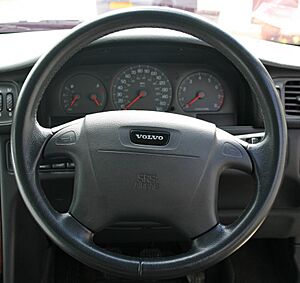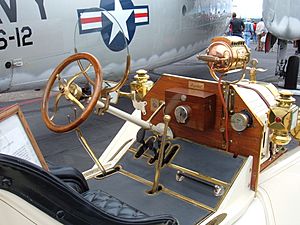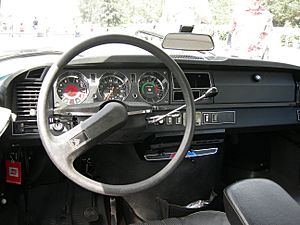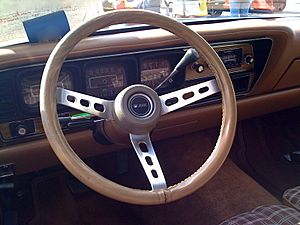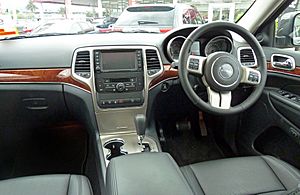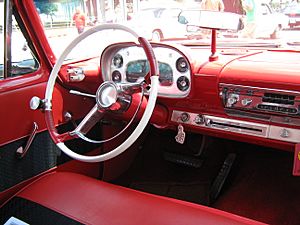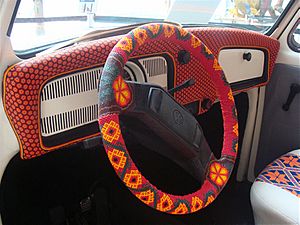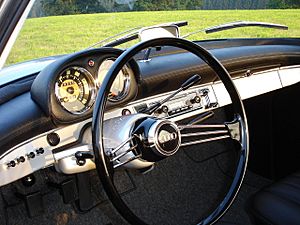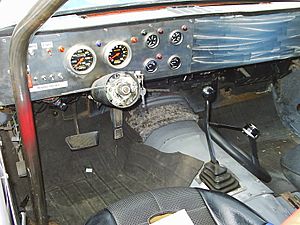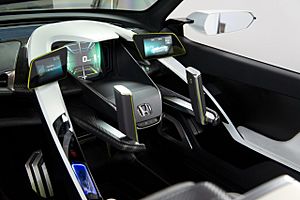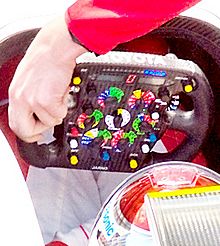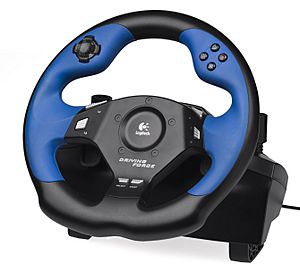Steering wheel facts for kids
A steering wheel is a very important part of most modern vehicles on land. This includes all cars, buses, trucks, and tractors. It's the part of the steering system that the driver uses to control the direction of the vehicle. The rest of the steering system then makes the wheels turn. This can happen through direct mechanical parts or with help from hydraulic power steering (HPS). Some newer cars even use computer-controlled motors, called Electric Power Steering, to help with steering.
Contents
How Steering Wheels Started
Before steering wheels, early cars used a "tiller." This was a lever that drivers pushed or pulled to turn the vehicle. Imagine steering a small boat with a stick – it was a bit like that!
In 1894, a man named Alfred Vacheron used a steering wheel in a race in France. This was one of the first times a steering wheel was used in a car. By 1898, some car companies like Panhard et Levassor started putting steering wheels in their cars as a standard feature.
An important change happened in 1903. Thomas B. Jeffery, a car maker, decided to move the driver's seat and the steering wheel to the left side of the car. Before this, many cars had the steering wheel on the right or even in the middle. Soon, most cars in the United States switched to having the steering wheel on the left. Within about ten years, the steering wheel had completely replaced the tiller in almost all cars.
Steering Wheels in Cars
Steering wheels in cars are usually round. They connect to the steering column with spokes. The number of spokes can be different, but most have two, three, or four. In countries where cars drive on the left side of the road, the steering wheel is usually on the right side of the car. This is called right-hand drive (RHD). If cars drive on the right side of the road, the steering wheel is on the left (left-hand drive or LHD).
Besides steering, the wheel is also where you usually find the button for the car's horn. Modern cars have many more controls on the steering wheel. You might find buttons for cruise control, the radio, or even to answer phone calls. This helps drivers keep their hands on the wheel and focus on the road.
Older steering wheels were very stiff. If there was a crash, the steering column could hurt the driver. To make cars safer, new rules were made. Now, steering columns are designed to collapse or break away in a serious crash. This helps protect the driver.
Power steering makes it much easier to turn the steering wheel. Without it, turning the wheel, especially when the car is stopped, would be very hard. Most power steering systems use hydraulics (liquid pressure), but newer cars are starting to use electric motors instead.
Different Steering Wheel Designs
Some special cars, like the McLaren F1 sports car or single-seat racing cars, have the driver's seat and steering wheel in the very center. This helps the driver feel more connected to the car.
Because drivers hold the steering wheel for a long time, they are designed to be comfortable. This is called ergonomics. The most important thing is that the driver can easily turn the wheel. Steering wheels are often made with a metal ring covered in plastic or rubber for a good grip. Some people add covers for more comfort or decoration. A "brodie knob" is a small handle that can be attached to the wheel to make turning easier with one hand.
You might see similar steering controls in other vehicles. Airplanes use a "yoke" which looks a bit like a steering wheel. Ships also use a "ship's wheel" to steer. The steering wheel design has lasted so long because it gives drivers the precise control and feedback they need.
Early Formula One race cars used steering wheels that were very similar to regular car steering wheels. They were often made of wood. As race cars became smaller and faster, their steering wheels also became smaller to fit into the tight cockpits.
Older cars often had four-spoke steering wheels. A special type called a "Banjo Steering Wheel" was popular on some early cars. These wheels had many thin wires in each spoke, which helped absorb vibrations from the road before power steering was common.
Adjustable Steering Wheels
Many steering wheels can be adjusted to make driving more comfortable for different people.
- Tilt wheel: This lets you move the steering wheel up and down in an arc. It helps you find the best position for your arms and hands.
- Adjustable steering column: This allows you to change the height of the steering wheel. Some even move automatically when you get in or out of the car.
- Telescope wheel: This lets you pull the steering wheel closer to you or push it further away. It's like a telescope that can extend or shorten.
- Swing-away steering wheel: Some older cars had steering wheels that could swing to the side when the car was in "Park." This made it easier for the driver to get in and out.
- Quick release hub: In racing cars, the steering wheel can be quickly removed by pressing a button. This helps drivers get in and out of the very small cockpits. It can also be used as an anti-theft device in other cars.
How to Use a Steering Wheel Safely
It's important to use the steering wheel correctly. You should try to keep your wrists straight and avoid bending them too much. This helps prevent strain on your hands and arms.
Turning the steering wheel when the car is not moving is called "dry steering." It's usually best to avoid this. Dry steering can put extra stress on the car's steering parts and wear out your tires faster.
Buttons and Controls on the Steering Wheel
The first button added to a steering wheel was for the electric horn. It was usually in the middle of the wheel. Sometimes, there was a special ring on the wheel that you could press to honk the horn.
Over time, more and more buttons appeared on steering wheels. In the 1960s, some cars started to have controls for cruise control on the steering wheel. By the 1980s and 1990s, it became common to find buttons for the radio, CD player, and even the car's phone system.
Today, modern steering wheels can have many buttons and scroll wheels. These let you change the volume, switch radio stations, answer calls, or control the car's navigation system. This way, drivers can keep their hands on the wheel and their eyes on the road.
Steering Wheels in Video Games
Many game controllers for racing video games are designed to look and feel like a real steering wheel. These are popular for racing games on computers and game consoles. Some of these gaming wheels even have "force feedback." This means the wheel can vibrate or push back, making it feel more like you're driving a real car and giving you a better gaming experience!
Images for kids
-
Steering wheel and front wheels of a farm tractor
-
Ford Thunderbird steering column "swung" to right
See also
 In Spanish: Volante de dirección para niños
In Spanish: Volante de dirección para niños


